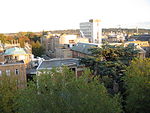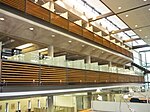Dyson Perrins Laboratory
1916 establishments in England2003 disestablishments in EnglandChemistry laboratoriesDepartments of the University of OxfordHistory of chemistry ... and 1 more
University and college laboratories in the United Kingdom

The Dyson Perrins Laboratory is in the science area of the University of Oxford and was the main centre for research into organic chemistry of the University from its foundation in 1916 until its closure as a research laboratory in 2003. Until 2018, parts of the building were used as teaching laboratories in which undergraduate students were trained in practical organic chemistry. It was founded with an endowment from Charles Dyson Perrins, heir to the Lea & Perrins Worcestershire sauce company, and stands on the north side of South Parks Road in Oxford.
Excerpt from the Wikipedia article Dyson Perrins Laboratory (License: CC BY-SA 3.0, Authors, Images).Dyson Perrins Laboratory
Parks Road, Oxford City Centre
Geographical coordinates (GPS) Address Nearby Places Show on map
Geographical coordinates (GPS)
| Latitude | Longitude |
|---|---|
| N 51.7584 ° | E -1.2537 ° |
Address
Science Area
Parks Road
OX1 3PD Oxford, City Centre
England, United Kingdom
Open on Google Maps










